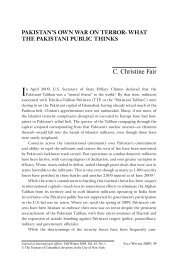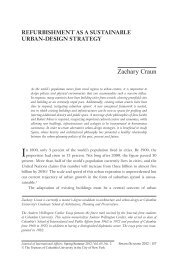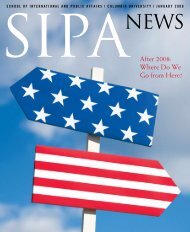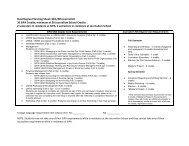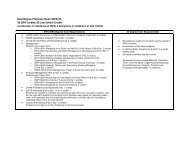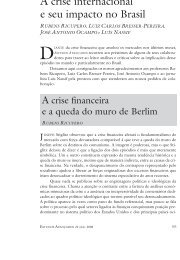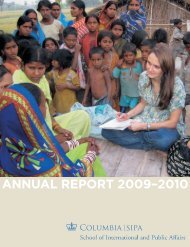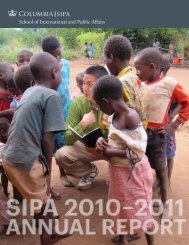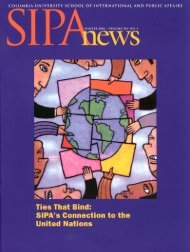SIPANewS - SIPA - Columbia University
SIPANewS - SIPA - Columbia University
SIPANewS - SIPA - Columbia University
You also want an ePaper? Increase the reach of your titles
YUMPU automatically turns print PDFs into web optimized ePapers that Google loves.
Supporters of Ukrainian<br />
opposition leader Viktor<br />
Yanukovych display his<br />
party flags, with a statue<br />
of Soviet state founder<br />
Vladimir Lenin in the<br />
background, at a campaign<br />
rally in the Crimean capital<br />
Simferopol, Ukraine, in<br />
December 2009.<br />
Post-Soviet Identity and Foreign Policy Formation<br />
in Ukraine, Estonia, and Latvia By Tim Sandole<br />
Ukraine, Estonia, and Latvia have two<br />
geopolitical similarities: each was a<br />
subject of the Soviet Union, and each<br />
shares a border with Russia. Yet despite<br />
their proximities to Russia and their respective<br />
experiences with Communism, the two Baltic states<br />
differ remarkably from Ukraine in their policy of<br />
engagement with Russia and the West. Upon the<br />
Soviet Union’s disintegration, Estonia and Latvia<br />
aggressively looked west and embraced NATO,<br />
while Ukraine looked west and continued looking<br />
east, maintaining ties with its former master while<br />
attempting to create a new relationship with the<br />
United States and Western institutions. Why did<br />
these three countries, which were geographically<br />
similar from the outset of the post-Cold War era, differ<br />
so remarkably in their foreign policy orientation?<br />
Their disparate foreign policies are a direct result of<br />
20 <strong>SIPA</strong> NEWS<br />
their respective national identities, all of which came<br />
to fruition during the Soviet Union’s disintegration.<br />
Ukraine’s “Middle-of-the-Road”<br />
Approach<br />
Ethnic Russians formed the largest minority in<br />
Ukraine, making up 22 percent of the population<br />
according to the 1989 census. Throughout the<br />
Soviet period, it was common for Russians to traverse<br />
various Soviet Socialist Republics because<br />
of favorable opportunities provided to them by<br />
the Communist Party. And even after Ukrainian<br />
independence, ethnic Russians had no reason to<br />
fear for their well-being, because Ukraine took<br />
a “middle ground” approach to policy formulation,<br />
where ethnic Russians and Ukrainians<br />
would be on an equal legal footing. <strong>Columbia</strong><br />
<strong>University</strong> professor Alfred Stepan explains that<br />
Ukraine “decided to recognize and institutionally<br />
give support to more than one cultural identity,<br />
even a national identity, in the state.” This<br />
moderate approach stemmed from the makeup<br />
of Ukrainian regional identity. Nationalist and<br />
anti-Russian sentiments have historically characterized<br />
western Ukrainian regions, notably in<br />
Galicia, where the Austrian Hapsburg Empire<br />
once ruled. This left a Western-oriented legacy<br />
in western Ukraine. Pro-Russian political values<br />
have been historically codified in eastern<br />
Ukraine, notably in Donetsk, as a consequence of<br />
many years of Russian Czarist rule. This regional<br />
dichotomy spawned three political ideologies in<br />
the Ukrainian parliament (Verkhvna Rada) at the<br />
outset of Ukrainian independence.<br />
The political left embraced the Soviet idea<br />
of Ukrainian origin belonging to an East Slavic






